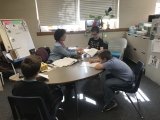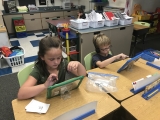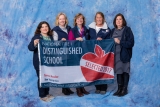-
Category 2
Selected in 2017
-
Grades: pre k - 5
School Setting: urban
Town Population: 43,000
Student Enrollment: 386
Student Demographics:
Black/African American: 4.7%
Teacher/Student Ratio: 1:20
White/Caucasian: 88.8%
Hispanic: 3.3%
Hawaiian/Pacific Islander: 1%
Asian: 2%
Native American: 0%
Other: 0.2%
% Reduced Lunch: 43%
% ELL Learners: 3.3%
Founded: 1987 -
PRINCIPAL:
Michele Vance -
CONTACT:
40 Sewalls Falls Road
Concord, NH 03301
603-225-0853
mvance@sau8.org
Beaver Meadow
Concord, NH
We truly believe that implementing a Professional Learning Community model has had the most sufficient impact on Beaver Meadow School.
- Describe specific programs in place to ensure that families are involved in the success of your school and students.
- One program that has ensured family involvement is our Family Resource Center. This weekly opportunity allows families with children from birth to age 5 to come to school each week and engage in learning opportunities that prepare their child(ren) for school. We have also offered extended day programs for students in both math and reading. Parents are invited to come in for conferences to discuss their child’s(ren’s) progress. We have been able to host evening events that connect parents to our math and literacy programs and prepare students to be ready for kindergarten. Newsletters and school messengers are sent our weekly to inform parents of upcoming events and opportunities for them to be involved.
- Describe the most successful activity your school has initiated to strengthen ties to your community.
- At Beaver Meadow School we have coordinated numerous activities that connect our school with our community. I believe one of the most successful activities would be our monthly All School Meetings. These meetings are student led and have a monthly peaceable theme. We highlight student’s academic growth, our featured arts, and a story that links our monthly peaceable theme with our PBIS rollouts. These meetings are well attended by our community and family members.
- Describe your philosophy of school change or improvement.
- My philosophy of school growth includes transparent communication that allows each stake holder a voice that will be heard and a chance to improve. When I came to Beaver Meadow School last year, I opened the year with a theme of “Good Seeds Grow in Strong Cultures.” This theme morphed to developing growth mindsets and creating a professional learning community that supported students’ social, emotional, and academic growth. My school needed opportunities to build trusting relationships and share their accomplishments and see failures as opportunities for growth. By creating a climate where we are all responsible for each student has truly opened new dialogues and a collaborative approach. My teachers do not see them themselves as silos, but rather a member of a team.
- What are your school’s top two goals for the next year?
- Our top two goals for next year are to continue to improve our multi-tiered system with social, emotional, and academic interventions which foster a whole child approach. Our school is also moving in a direction to become a trauma sensitive school that has parallel supports in place for staff and students.
- What is the single most important factor in the success of your school that others could replicate?
- I truly believe that implementing a Professional Learning Community model has had the most sufficient impact on Beaver Meadow School. Our climate and cultural has positively changed and a collaborative team has been born. I am extremely proud of the work my teachers and students participate in daily and feel blessed to witness to our growth.
- Describe the program or initiative that has had the greatest positive effect on student achievement, including closing achievement or opportunity gaps, if applicable.
- Since implementing a Professional Learning Community Model at Beaver Meadow School our teachers have effectively implemented a multi-tiered support system to progress monitor students’ growth. Teams meet to discuss the four critical questions and look at student’s formative data to make instructional decisions. Each trimester we schedule a data day and spend ½ a day looking at grade level data and classroom data to discuss possible sharing of effective instructional strategies.
- Explain how Title I funds are used to support your improvement efforts.
- We have used Title I funds to increase family engagement by offering numerous math and literacy nights. We have also used these funds to open a family resource support center, which meets once a week and has expanded to include 24 families. Our funding has been used to build the capacity of my teachers and tutors with research based intervention programs, which has increased student achievement levels in both reading and math. Funding has also allowed us to focus on our learning climate and implement schoolwide positive behavior intervention system (PBIS). My Universal Team meets bi-monthly to create educational learning activities that foster students social and emotional growth to make safe, respectful, and responsible choices.
- Identify the critical professional development activities you use to improve teaching and student learning.
- The critical professional development activities that have improved teaching and student achievement include attendance at the following conferences and/or workshops: Professional Learning Communities, Social Thinking, Zones of Regulation, Fundations, Mindfulness, Data Driven Protocols, and book studies on Mindset & Visible Learning. Staff who have attended any of these professional opportunities have then shared their experiences and knowledge with their colleagues at monthly staff meetings.
- Describe how data is used to improve student achievement and inform decision making.
- At grade level PLCs our teams focus on learning targets and use formative assessments to sort students that require Tier 2 or Tier 3 instruction. A schedule has been designed so that each grade level has support during differentiated blocks of time so that teachers are able to provide students with small group instruction. Interventions are discussed at PLCs and student’s academic needs are matched to research based interventions. At the beginning of the school year we gathered data from our universal assessments and developed SMART goals at each grade level and at the school level. These goals provide teams with a focus and allow them to monitor student progress towards the goals developed.
- Describe your school culture and explain changes you’ve taken to improve it.
- Our school culture has changed drastically as a direct result of implementing a Professional Learning Community Model. Last year two separate teams were able to attend either the PLC Summit or the PLC Institute. Since those conferences, grade level and vertical teams have begun to share ownership of all student growth and make decisions based on data driven protocols. As a response to a staff survey, our Leadership Team has created an action plan to support professional development opportunities for staff and students that foster growth mindsets.
Stats
-
Category 2
Selected in 2017
-
Grades: pre k - 5
School Setting: urban
Town Population: 43,000
Student Enrollment: 386
Student Demographics:
Black/African American: 4.7%
Teacher/Student Ratio: 1:20
White/Caucasian: 88.8%
Hispanic: 3.3%
Hawaiian/Pacific Islander: 1%
Asian: 2%
Native American: 0%
Other: 0.2%
% Reduced Lunch: 43%
% ELL Learners: 3.3%
Founded: 1987 -
PRINCIPAL:
Michele Vance -
CONTACT:
40 Sewalls Falls Road
Concord, NH 03301
603-225-0853
mvance@sau8.org







